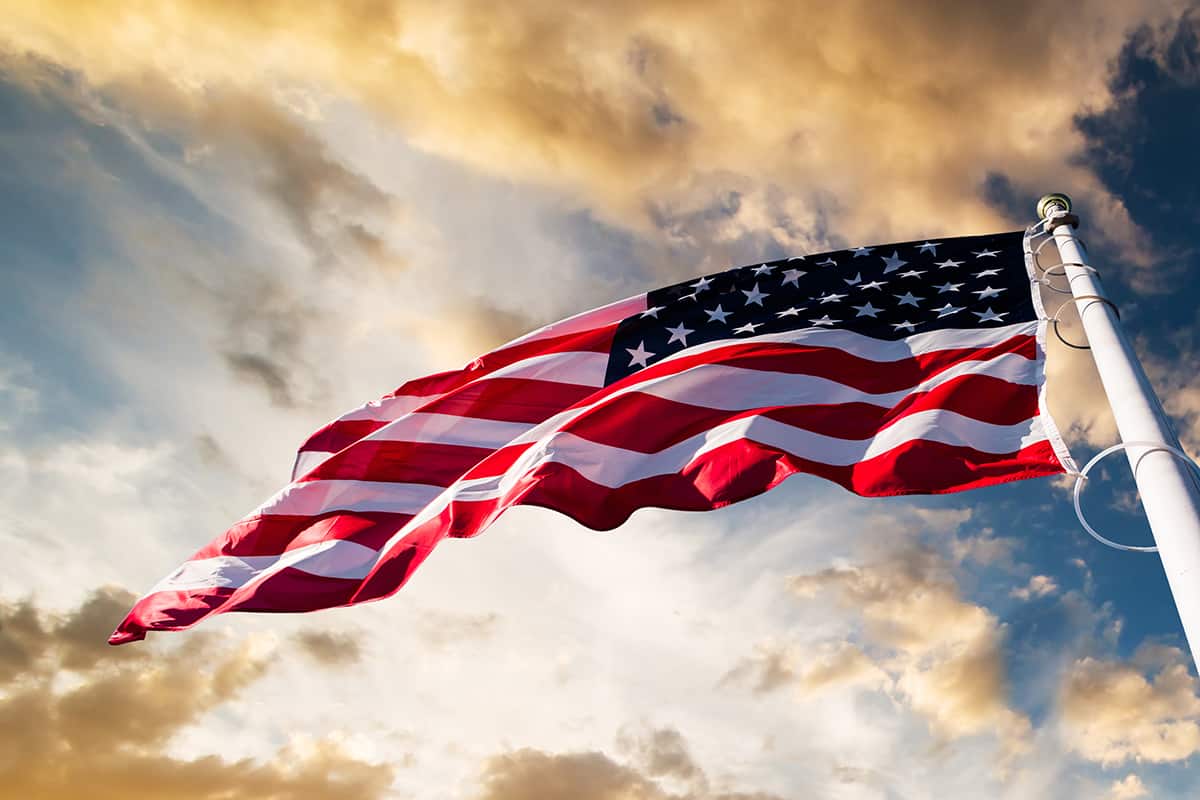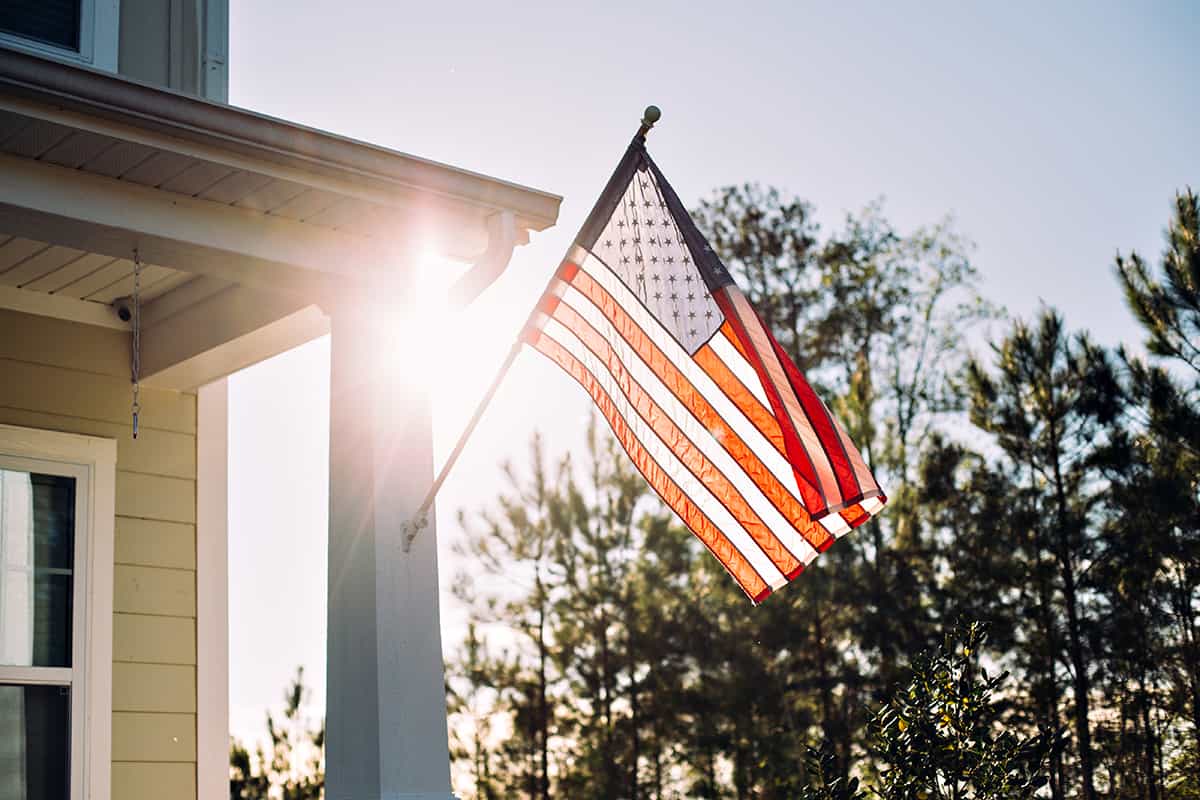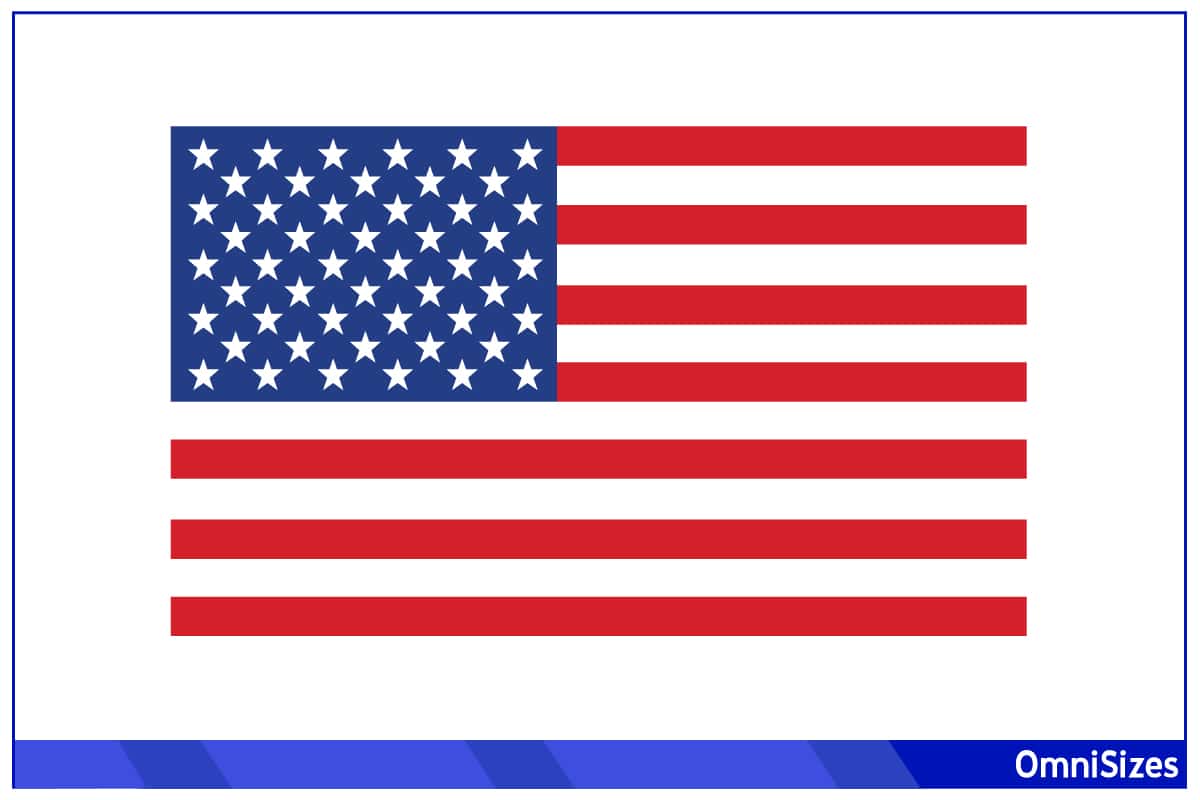The American flag is a powerful symbol of patriotism and national identity. American flag sizes vary widely, depending on where it’s hanging. So, if you’d like to show respect for our wonderful country, what flag size is appropriate?
American flags used for executive agencies must have a height-to-width ratio of 1:1.9, with minor exceptions. The following chart describes standard American flag sizes, but you can find them in all sorts of size and proportion ratios.
| Height | Height |
| 1.32 feet | 2.5 feet |
| 2.37 feet | 4.5 feet |
| 3 feet | 4 feet |
| 3 feet | 5.7 feet |
| 3.5 feet | 6.65 feet |
| 4.33 feet | 5.5 feet |
| 5 feet | 9.5 feet |
| 7 feet | 11 feet |
| 8.95 feet | 17 feet |
| 10 feet | 19 feet |
| 20 feet | 38 feet |
There’s still so much more to unpack regarding American flag size proportions. So, if you’d like to learn more about flag’s design, sizes, and hoisting protocols, please continue reading.
The American Flag’s Design and Its Origins

The American flag, often referred to as the “Stars and Stripes,” is a symbol of American history and identity. Its design has evolved over the years, mirroring the growth of the nation.
Birth of the Flag
The American flag’s journey began on June 14, 1777, when the Continental Congress passed a resolution setting the flag’s design as 13 stripes, alternating red and white, and 13 white stars on a blue field. This represented the original 13 colonies. The flag’s design was likely influenced by the Grand Union Flag, which combined British Union Jack and the stripes signifying colonial unity.
Evolution of Stars and Stripes
As the U.S. expanded, so did the flag. New stars were added for each new state. The current 50-star flag dates from July 4, 1960, after Hawaii’s admission. The flag has seen 27 versions, with each telling a story of America’s development.
American Flag Size Standards
The American flag has specific size standards that are more than just numbers. These standards ensure uniformity and respect for the flag, especially when displayed alongside other flags.
Executive Order 10834
Executive Order 10834, issued by President Dwight D. Eisenhower in 1959, sets the standard proportions and sizes for the American flag. This order outlines detailed specifications, including the flag’s dimensions.
Proportions and Dimensions
According to the Executive Order, the flag’s hoist-to-fly (height-to-width) ratio is 1.9, meaning the flag’s length is almost twice its width. Standard sizes include 3 × 5 feet (91.44 × 152.4 cm) and 4 × 6 feet (121.92 × 182.88 cm), among others. These sizes are designed for various uses, from personal to official settings.
Size Guidelines for Different Settings
For residential use, smaller flags are common, like 3 × 5 feet. In contrast, larger buildings often display bigger flags, such as 5 feet × 8 feet (152.4 × 243.84 cm) or 6 feet × 10 feet (182.88 × 304.8 cm), for a grander display. The size choice depends on the flagpole height and the building’s scale.
Parts of an American Flag
The American flag is more than just stars and stripes. Its design is a complex composition of various parts with specific dimensions and symbolism.
1. The Union (Canton)
The Union, or canton, is the blue rectangle in the flag’s top-left corner. It represents the unity of the states.
Its height, or the hoist of the canton, is 0.5385 times the flag’s height, spanning 7 stripes. The Union’s width, or the fly of the canton, is 0.76 times the flag’s width, making it 2/5 of the flag’s total width.
2. The Stars in the Union
The 50 stars in the canton symbolize the 50 states.
The distance between the stars vertically is 0.0538 times the height of the Union, or about 1/10. Horizontally, the distance is 0.0633 times the Union’s width, or roughly 1/12. This spacing provides ample space for even spacing between the stars. Each star’s diameter is 0.0616 times the width of a stripe, which is 4/5 of a stripe’s width.
3. The Stripes
The flag features 13 horizontal stripes, representing the original 13 colonies. These stripes alternate between red and white, starting and ending with red.
Each stripe’s width is 0.0769 times the flag’s height, which is about 1/13 of the flag’s total height.
Summary Chart
| Parts of the American Flag | Proportions | Dimensions on a 3 × 5.7-foot American Flag |
| The Union (Canton) | Height: 0.5385 of flag height Width: 0.76 of flag width |
Height: 19.39 inches Width: 51.98 inches |
| The Stars in the Union | Vertical spacing: 0.0538 of Union height Horizontal spacing: 0.0633 of Union width Star diameter: 0.0616 of stripe width |
Vertical spacing: 1.04 inches Horizontal spacing: 3.29 inches Star diameter: 0.17 inches |
| The Stripes | Width: 0.0769 of flag height | Stripe width: 2.77 inches |
Protocol for Displaying an American Flag

Hoisting and lowering the American flag is a symbolic act that is filled with respect and tradition. It’s a meaningful ritual that reflects honor and national pride.
1. Basics of Flag Hoisting
Raising the American flag is usually done briskly and with respect. The flag should be attached to the halyard (the rope used for raising the flag) without it touching the ground. Once secured, it’s raised swiftly to the top of the flagpole.
2. Proper Time for Display
According to Public Law 94-344, the flag should be displayed from sunrise to sunset on buildings and outdoor stationary flagstaffs. However, the flag can be displayed 24 hours a day if it’s illuminated during the hours of darkness.
3. Lowering the Flag
Lowering the flag is done ceremoniously and slowly to symbolize the end of the day or completion of an event. The flag is carefully gathered and not allowed to touch the ground or any object beneath it.
4. Half-Staff Protocol
Flying the flag at half-staff is a sign of mourning. When the flag is lowered to half-staff, it should first be raised to the peak for a moment and then lowered to the half-staff position. At the end of the day, the flag should raise to its peak height before being lowered ceremoniously.
5. Special Days for Half-Staff
There are specific days when the flag is flown at half-staff, like Memorial Day. This practice honors the memory of individuals and events that have significantly impacted the nation.
6. Inclement Weather Conditions
Normally, the flag should not be displayed in inclement weather (such as rain, snow, or wind storms) unless it’s an all-weather flag (made of weather-resistant materials like nylon).
7. Raising Multiple Flags
When the American flag is flown with other flags (like state flags), it should be hoisted first and lowered last. This honors the flag’s status and ensures it holds a place of prominence.
8. National Anthem Protocol
During the playing of the National Anthem, the flag should be hoisted at the beginning and lowered at the end. This practice aligns the symbolism of the anthem with the visual representation of the flag.
9. Disposal of Worn Flags
Worn or damaged flags should be retired with dignity, preferably by burning. This should be done in a respectful setting to signify the flag’s end of service.






